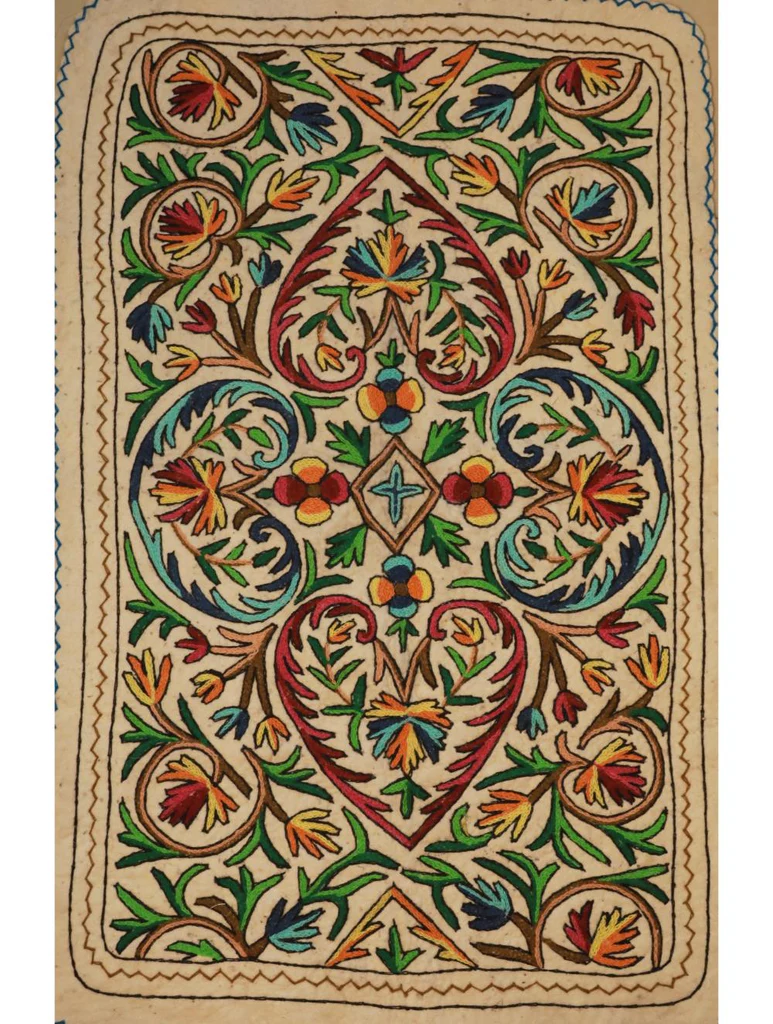
Namda rugs, crafted with a unique felting technique, represent one of the most iconic and treasured crafts of Kashmir. Unlike woven or knotted rugs, Namda is created through a felting process that compresses wool fibers, forming a solid and cohesive layer that is both soft and incredibly warm. Originating in the cold regions of Kashmir, these rugs are prized not only for their functionality but also for their aesthetic appeal, featuring intricate designs and vibrant colors that reflect Kashmiri culture. Namda rugs have adorned homes in the region for centuries, providing a sense of warmth and comfort during harsh winters while embodying the rich history and artistic legacy of Kashmiri artisans.
Table of Contents
The Origin and History of Namda in Kashmir
The art of Namda rug-making is believed to have been introduced to Kashmir by artisans from Central Asia as early as the 11th century. Initially crafted as luxurious gifts for the ruling elite, these rugs were celebrated for their warmth, comfort, and beauty. Over time, this craft spread beyond the courts and into the homes of ordinary Kashmiris. The rug has always held a place of honor in Kashmiri households, often handed down through generations as treasured heirlooms. Each rug carries the weight of history, with patterns and designs that narrate stories from the region’s folklore and reflect the craftsmanship honed over centuries. Today, these rugs are recognized globally as one of the finest examples of Kashmiri art, preserving the heritage of an ancient craft in the face of modernization.

What Makes Namda Unique?
Characteristics of Namda
Namda rugs are defined by their dense, felted structure, which gives them a unique texture that is both soft and sturdy. This felting process, a hallmark of Namda, involves compressing wool fibers without the use of weaving techniques. The result is a rug that feels almost cushion-like underfoot yet is resilient enough to withstand daily use. Unlike other rugs that rely on weaving for durability, this rug’s strength lies in its tightly bonded fibers, making it an ideal insulator against cold floors. The thick, cushioned texture also makes the rug incredibly comfortable, and its weight is light enough to be easily relocated, adding to its practicality in modern homes.
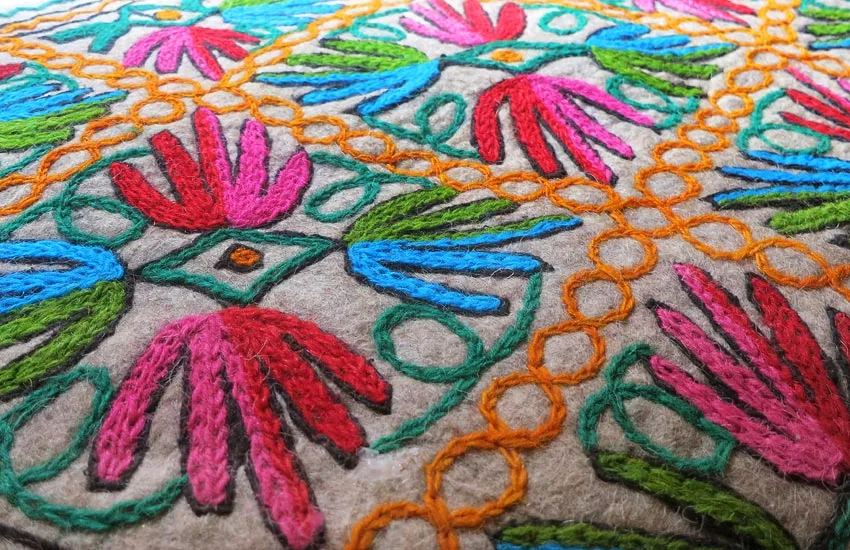
photo/gaatha
Types of Designs and Patterns
Namda rugs are renowned for their stunning patterns, which range from intricate floral designs inspired by the natural beauty of Kashmir to geometric motifs that reflect the influence of Central Asian artistry. Artisans hand-embroider these patterns onto the felted surface, transforming a simple rug into a visual masterpiece. The colors are chosen with care, often reflecting the vibrant hues found in Kashmiri landscapes—think lush greens, deep blues, and fiery reds. Each design is unique, with some motifs passed down as family secrets, ensuring that no two rugs are ever exactly alike. These patterns not only add beauty but also carry cultural and symbolic meanings, adding depth to the visual appeal.

photo/theindiacrafthouse
The Craftsmanship Behind Namda
Wool Selection
The quality of wool used in this rugs is crucial to their durability and comfort. Kashmiri artisans typically select wool from local sheep, which is known for its thick, resilient fibers that lend themselves well to the felting process. This wool has the right blend of softness and strength, ensuring the rug is both comfortable to touch and long-lasting. Artisans carefully inspect each batch of wool, choosing fibers based on their texture, length, and purity. This meticulous selection process is essential to creating high-quality rug that withstands the test of time. The wool is then cleaned and carded to remove impurities, preparing it for the felting process.
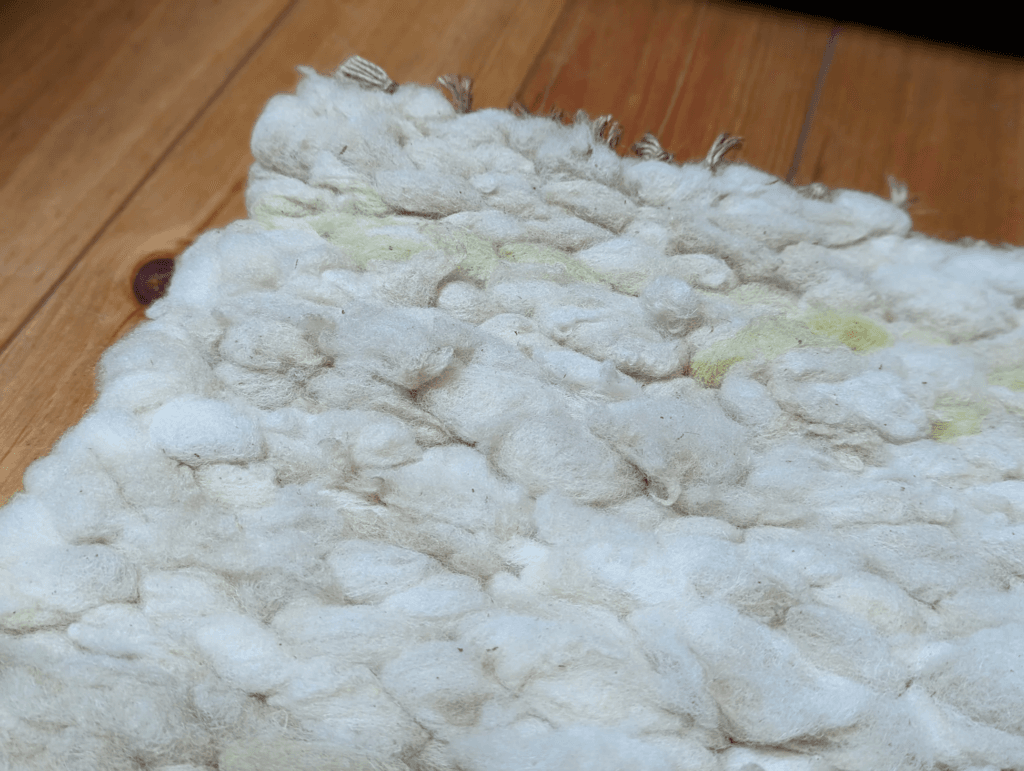
photo/naturallywoodland
Traditional Dyeing Techniques
One of the defining features of Namda is its rich, vibrant colors, achieved through traditional dyeing techniques that have been used for centuries. Many artisans prefer natural dyes derived from local plants, minerals, and roots, which create earthy tones that are both visually appealing and eco-friendly. These dyes are known for their depth and durability, adding a sense of authenticity to each rug. The dyeing process is labor-intensive, with artisans carefully balancing the right ingredients to achieve the desired hues. Synthetic dyes have also been introduced in recent years to expand the color palette, but many artisans still hold a preference for the natural dyes that honor the traditional aesthetic.
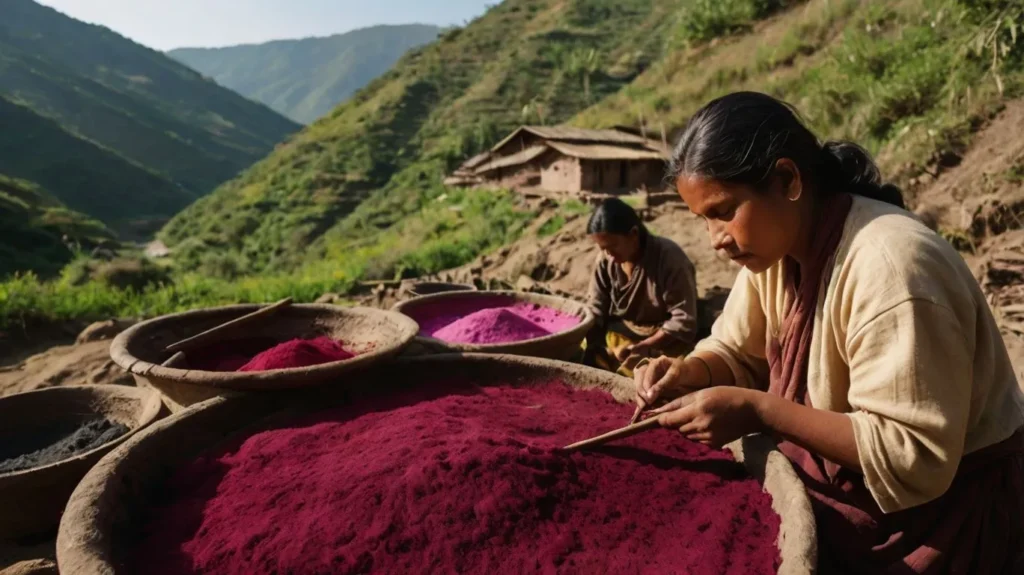
How Namda Rugs Are Made
The Felting Process
The felting process is the heart of Namda-making, transforming loose wool fibers into a dense, cohesive rug. To begin, artisans spread a thin layer of wool onto a flat surface, often on top of a cloth base. Water is then added, and the fibers are agitated and pounded with heavy wooden tools to encourage the wool to bind. This process is repeated until the wool becomes tightly interlocked, creating a dense, flat layer of felt. The felting process requires patience and skill, as it takes precise handling to ensure the wool fibers bond evenly. The result is a smooth, durable fabric that serves as the foundation of every rug.
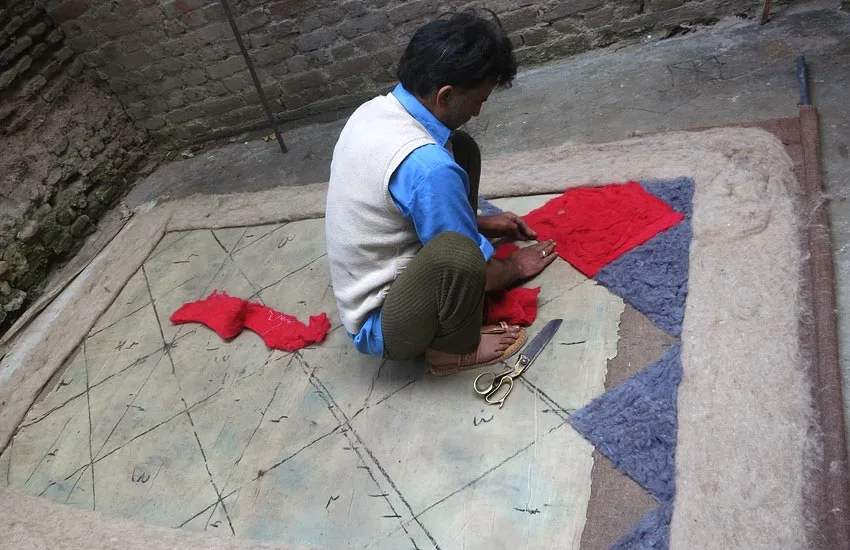
photo/gaatha
Adding the Intricate Embroidery
Once the rug is felted, the real artistry begins with the addition of intricate embroidery. Using needles and colored threads, artisans carefully stitch designs onto the felt surface, often following traditional motifs passed down through generations. Each stitch is placed with precision, and the embroidery adds a layer of texture and depth to the rug, transforming it into a work of art. The embroidery process can take days, depending on the complexity of the design, and it requires a steady hand and an eye for detail. This is the stage where artisans truly express their creativity, bringing each rug to life with patterns that capture the essence of Kashmiri culture.
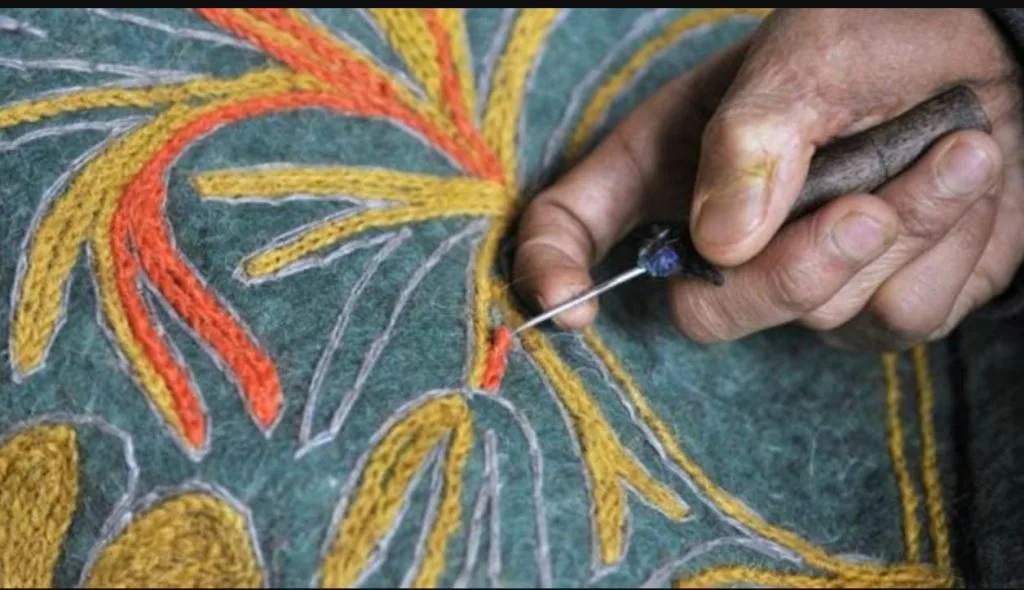
photo/hcssc
Also Read – India-Kashmir: The Timeless Beauty of Copperware Craft
Types of Namda Rugs
Plain
Plain Namda rugs are crafted without any additional embellishments, showcasing the natural beauty of felted wool. These rugs have a simple, elegant appeal and are ideal for minimalist interiors that favor subtle, neutral designs. Despite their simplicity, plain rugs are incredibly warm and comfortable, making them a practical choice for areas where functionality is key.
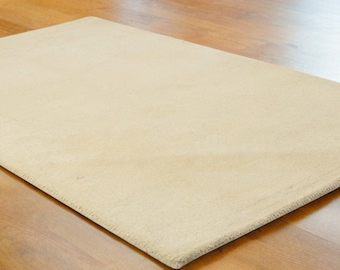
photo/etsy
Embroidered
Embroidered Namda rugs are the most popular variety, featuring intricate patterns and motifs that reflect Kashmiri culture. These rugs are highly decorative and serve as statement pieces in any room, with patterns that range from floral designs to geometric shapes. The embroidery adds a layer of sophistication, making these rugs perfect for spaces where a touch of traditional artistry is desired.
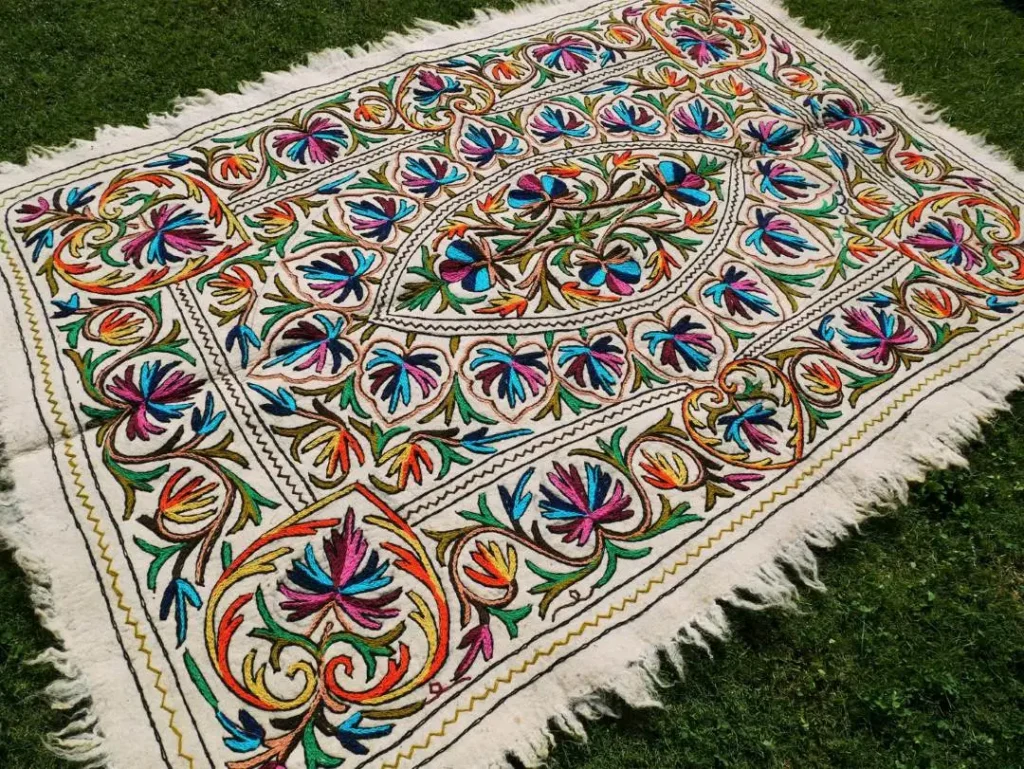
photo/theshantihome
Decorated
Decorated rugs take embellishment a step further, incorporating additional elements like tassels, appliqués, or even small mirrors. These rugs are highly ornamental, showcasing the full extent of Kashmiri craftsmanship. Decorated Namda is ideal for those looking to add a luxurious, bohemian touch to their home décor.
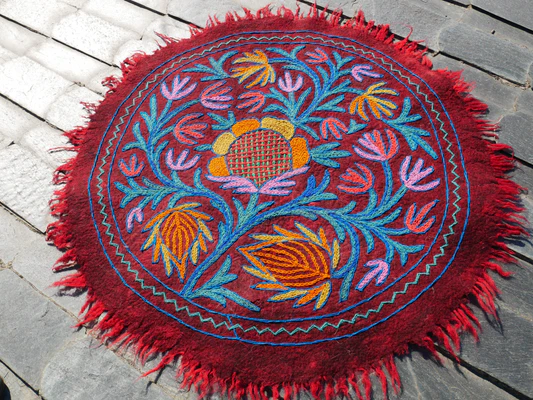
photo/theshantihome
The Role of Namda in Kashmiri Culture
In Kashmir, Namda rugs are more than just functional items—they hold deep cultural significance. These rugs are often used during social gatherings, serving as seating arrangements that bring people together. It is also a traditional gift item, symbolizing warmth and care. The craft of making rug is passed down through families, with each generation learning the skills needed to preserve this unique art form. The cultural value is immense, as they embody the history, tradition, and identity of Kashmiri artisans.
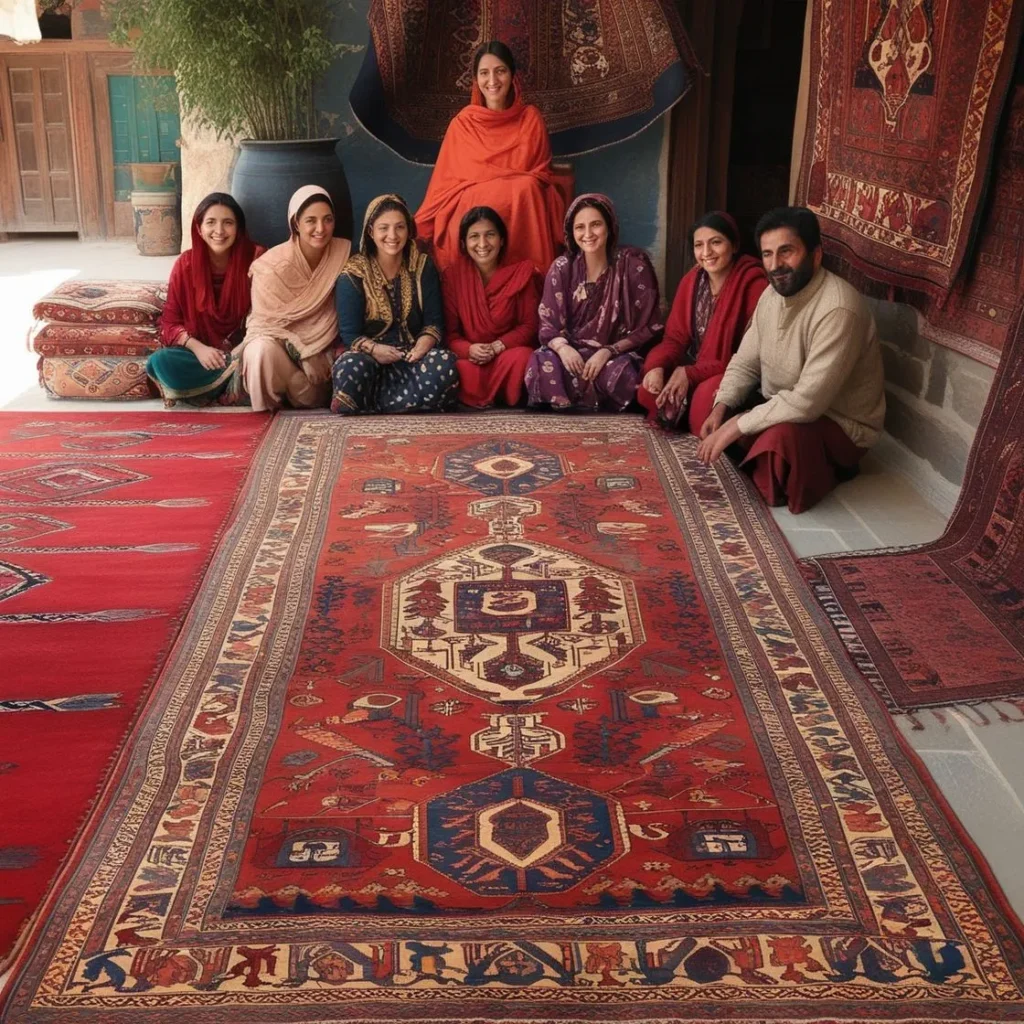
The Significance of Namda in Global Markets
Export and Popularity Worldwide
Namda rugs have gained international acclaim, especially in markets that value handmade, sustainable products. The rugs are exported to countries like the United States, the United Kingdom, and various European nations, where they are valued for their craftsmanship and authenticity. In recent years, the demand has grown as more consumers seek out sustainable, eco-friendly décor options. This global interest not only helps to preserve the industry but also brings Kashmiri culture to a broader audience.
Recognitions and Certifications
To protect and promote the authenticity of Namda rugs, the Indian government has granted the craft Geographical Indication (GI) status. This certification ensures that only rugs made in Kashmir by skilled artisans can be labeled as authentic, safeguarding the craft from imitations. GI certification also provides artisans with a mark of quality that boosts their product’s credibility in international markets, making it a highly valued and recognized item worldwide.

photo/greaterkashmir
Challenges Facing the Namda Industry
Decline in Artisans
The industry faces a significant challenge as younger generations show less interest in learning the craft. Many artisans struggle to earn a sustainable income, leading them to seek alternative employment. As a result, the number of skilled makers is dwindling, and with it, the knowledge of traditional techniques that have been passed down for generations.
Economic Struggles
The high cost of materials, combined with the time-intensive process of making Namda, makes it difficult for artisans to compete with cheaper, machine-made alternatives. Without sufficient market access or fair compensation, many artisans find it challenging to sustain their livelihoods. This economic pressure threatens the survival of the craft.
Competition from Machine-Made Rugs
Machine-made rugs are widely available and offer a lower-cost alternative to handmade, making it harder for artisans to compete. These machine-made versions lack the quality, authenticity, and cultural significance of traditional Namda but appeal to consumers looking for affordable options.
Government and NGO Efforts to Revive Namda
The Indian government and several NGOs have launched initiatives to revive the Namda industry by providing financial support, training, and market access. These efforts aim to preserve the craft, promote Kashmiri culture, and uplift the artisans economically.
The Revival: Contemporary Uses of Namda
Modern Designs and Colors
Today, Namda artisans experiment with modern designs and colors to appeal to a broader audience. This adaptation helps them tap into contemporary markets and interior design trends.
Adaptation in Interior Design
Namda rugs are now being used in various interior design styles, from bohemian to minimalist spaces. Their versatility and artistic appeal make them a great choice for those seeking eco-friendly and handmade décor.
How to Care for Namda Rugs
Cleaning and Maintenance Tips
To clean rugs, gently vacuum or brush them to remove dust. Avoid using water excessively, as it can weaken the felt structure. For deeper cleaning, seek professional services to preserve the rug’s quality.
Preserving the Color and Quality
To retain the color, keep it out of direct sunlight, which can cause fading. Regular rotation can also help distribute wear evenly, keeping the rug in good condition.
Namda in Kashmir at a Glance:
| Aspect | Details |
|---|---|
| Introduction | Namda rugs are traditional Kashmiri felted wool rugs, valued for their warmth, softness, and intricate designs. These rugs have been crafted in Kashmir for centuries and reflect the region’s rich cultural heritage. |
| Origin and History | Originated in Central Asia and introduced to Kashmir around the 11th century. Initially crafted for royalty, the art eventually became accessible to the general population, becoming a symbol of Kashmiri heritage and artisanal mastery. |
| Uniqueness | Namda rugs are unique due to their dense, felted structure, crafted without weaving. This results in a soft yet sturdy rug with insulation properties ideal for cold climates. Designs are vibrant, reflecting Kashmiri flora and landscapes. |
| Characteristics | Made from thick, felted wool. Soft, cushion-like texture with excellent warmth and durability. Light enough to move around easily. |
| Types of Designs | Patterns include floral and geometric motifs inspired by Kashmiri nature and folklore. Each rug has unique designs, often embroidered by hand, with colors chosen to represent the region’s beauty. |
| Craftsmanship | Artisans select local wool for its softness and resilience. The wool is carefully cleaned, dyed, and prepared for felting and embroidery. |
| Wool Selection | Wool is chosen for its quality and texture, mainly from local sheep. The wool is durable, comfortable, and carefully inspected for purity. |
| Dyeing Techniques | Traditionally uses natural dyes from local plants, minerals, and roots for authentic colors. Synthetic dyes are sometimes used to expand the color palette. |
| Felting Process | Wool is layered, moistened, and pounded with wooden tools until fibers bond tightly. This creates a solid, smooth, and dense layer of felt that forms the rug’s base. |
| Embroidery Process | Artisans add intricate, hand-stitched patterns to the felted base, using threads to enhance the rug’s visual appeal with culturally significant motifs. |
| Types of Namda Rugs | – Plain: Simple and elegant, without additional decorations, suitable for minimalist interiors. – Embroidered: Features intricate designs, ideal for decorative use. – Decorated: Highly ornate with embellishments like tassels and appliqués. |
| Cultural Role | Namda rugs are culturally significant in Kashmir, often used for social gatherings and as cherished family heirlooms. Symbolize warmth, care, and traditional values. |
| Global Popularity | These rugs are exported globally, especially to Western markets valuing handmade crafts. Growing demand supports the Kashmiri artisan community and promotes cultural heritage. |
| Recognition | Craft has Geographical Indication (GI) status in India, ensuring only authentic Kashmiri rugs carry the “Namda” label, protecting artisans and preserving quality. |
| Challenges | – Decline in Artisans: Younger generations are less inclined to learn the craft. – Economic Struggles: High cost of materials and competition with machine-made rugs. – Machine Competition: Cheaper, machine-made options threaten the traditional industry. |
Conclusion: The Lasting Legacy of Namda
These rugs are more than just a decorative or functional item; they are a symbol of Kashmiri culture, artistry, and resilience. Each rug tells a story of tradition, craftsmanship, and dedication to preserving a centuries-old art form. While the Namda industry faces challenges, the growing global appreciation for handmade, sustainable crafts offers hope for the future. By supporting authentic artisans, consumers can contribute to preserving this beautiful craft for generations to come.
FAQs
What is the origin of Namda rugs?
Namda originated in Central Asia and was introduced to Kashmir centuries ago, where it became a beloved craft.
How can I care for my Namda rug?
Namda rugs should be gently vacuumed and kept away from moisture to maintain their quality.
How long does it take to make a Namda rug?
Depending on the complexity, crafting a single rug can take several days or even weeks to complete.
Are Namda rugs suitable for all climates?
Yes, these rugs are versatile, though they are especially useful in colder regions due to their warmth.
Where can I buy authentic Namda rugs?
You can find authentic rugs through online marketplaces supporting artisans or specialty stores focusing on Kashmiri crafts.
One thought on “India-Kashmir: Namda The Handmade Rugs That Tell a Story”